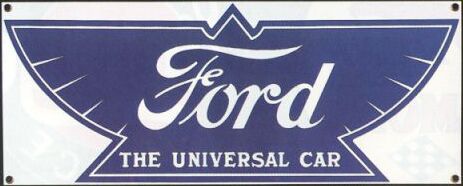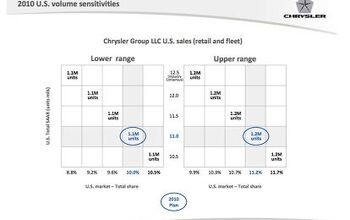Year-End Sales Report: Ford
Only three automakers lost retail market share last year, as the market for new cars struggled back from the depths of “Carpocalypse.” Battered as it was by a recall scandal that engulfed most of the auto media coverage for the first half of the year, Toyota’s 1.2% dip came as little surprise. But with all the positive spin surrounding GM and Chrysler, the bailed-out automakers loss of 1.8% and .6% retail market share was a pretty huge disappointment. Ford, on the other hand, drew a huge distinction from its cross-town rivals, recording the second-largest growth in retail market share of all automakers in the US market, snagging an additional 1.2% of the market. Projecting 2010’s trends forward a year (a speculative exercise, no doubt) Ford would actually surpass GM in terms of retail market share, putting it second only to Toyota (and within spitting distance (.3%) of first place). As the bailed-out automakers lose ground in the battle for consumers (rather than volume), Ford makes a strong case for exempting itself from the “Detroit” pejorative: at least as far as consumer perceptions go, Ford has little in common with GM or Chrysler. Not that there aren’t still trouble spots…
In terms of overall volume, Ford fell just short of the 2m mark for only the second time in recent history last year, notching 1,935,462 sales. And in terms of brand strategy, the contrast to GM couldn’t be stronger: with Mercury marked for death, the entry-luxe brand added just under 1k new sales last year, and Lincoln had a thoroughly mediocre year, adding fewer than 3k new sales. FoMoCo enjoyed none of GM’s flashy sub-brand growth numbers because Ford spent 2010 working on its core brand, with the result that Ford’s 21.5% volume boost amounted to 310,697 incremental units over 2009. You have to go back to 2001 to find a time when the entire Mercury made that kind of volume in a year.
Lincoln and Mercury both lost .1% of the retail market last year, but the Ford brand attracted more new retail customers than any other brand in the US last year, snagging an additional 1.3% of the market. That makes Ford the second-most popular brand with retail consumers, with 13.2% of the market, and if 2010’s performance is replicated next year, Ford will surpass Toyota at the top of the retail market share heap. And that’s despite the fact that Ford was targeting a 30% fleet mix for 2010. Which brings up an important point: fleet sales can be OK if retail share grows as well. Where GM (specifically Chevy) is replacing lost retail share with fleet sales, Ford is growing both (and surpassing GM in government fleet sales, widely considered to be among the “best” fleet sale).
And a look at Ford’s car sales indicates that Ford is succeeding with the retail market for reasons other than the newness or hotness of its products. Jack Baruth has already marveled at the success of the facelifted Fusion, which had its best year ever, up 21% to 219,219 units. But facelifts can often account for a 20% bump… what’s truly indicative of what Ford has been able to do in the post-bailout environment is the Focus. A three year old design that has never done particularly well with critics, the Ameri-Focus ended its last full year of sales up 7.5% at 172,421 units. That’s good for 3rd place in the segment after Civic and Corolla, creaming Sentra, Cobalt/Cruze combined, Elantra and Mazda3. It’s one thing for an American brand to take third place in the C-Segment, but it’s quite another to do so with an about-to-be-replaced refresh of a ten-year-old car. And Focus was Ford’s slowest-growing car nameplate (other than Crown Vic), as Taurus was up 51 percent (to 68,859 units), and Mustang was up 10.6% (to 73,716 units). Fiesta is off to a slowish start, but its year-end numbers (23,273 units) don’t tell much of a story, other than that gas prices are still relatively low.
Turning to Crossovers, Escape just barely lost out to Honda’s CR-V for the top volume spot among compact CUVs, growing a steady 10.4% to 191,026. Edge’s Fusion-style facelift helped bring the model back over 100k units after a poor 2009, up 34% to 118,637. Flex, however, continued to be a sales disappointment, as it lost 11.6% of its 2009 volume, falling to just 34,227 units. Considering how much better GM’s Lambdas sell (Traverse topped 100k units), the Flex’s underperformance is unforgivable. And because it’s such a goofy-looking box of a vehicle, a facelift will hardly do the trick. Ford’s doubtless banking on the Flex’s new platform-mate, the 2011 Explorer, to help give its large CUV effort a boost (and with over 10k December sales, they may be on to something there), but at this point the Flex joins the Taurus X and Freestyle in a long line of Ford failure in this segment. And given how many SUVs Ford sold in the day, this decade of large CUV irrelevance is more than just a embarrassment, it was a lost opportunity.
And though Ford showed consistency across cars and CUVs, trucks were where the Blue Oval made its money last year. F-Series was up 27.7%, which amounted to over 110k units of incremental volume. Ranger stayed flat on the year, giving up fewer than 300 sales compared to the year before, even as the compact pickup withers away. Econoline jumped to 108,258 units, most of which likely went to fleet clients, and creamed the European upstart, the Transit Connect, which managed a mere 27,405 units.
And what of Lincoln? At 85k units, its sales may have been up 3.6 percent, but incremental volume was less than 3k units, and it actually lost .1% of the retail market. That’s bad news for the brand that now holds all of Ford’s luxury aspirations. MKZ held fast last year at 22,535 units, an increase of fewer than 500 units. MKX added 499 units, to 21,932. MKS actually lost volume, dropping 16.1% to 14,417 units. That puts Lincoln’s “flagship” at about the same sales rate of other luxury flagships… like the Mercedes S-Class, which starts at twice the price of the MKS. The more comparable Mercedes, the E-Class, sold four times the MKS’s volume. MKT staged a big comeback in terms of percentages, but still only moved 7,435 units. And with December volume at 638, the MKT seems to be replicating the Flex’s failure. Thanks goodness Navigator is still around to provide 8k-ish sales every year, otherwise Lincoln’s volume would have fallen under the 80k mark for the first time in recent history.
Going into the new year, Ford’s strength will continue to derive from its Ford brand, which should improve considerably with the introduction of a new Focus, and its crossover and MPV derivatives. With retail share improvements almost unavoidable for the Ford brand, the only question mark standing in the way of its retail market supremacy is the extent to which Toyota retail share will continue to slide. But unlike Ford, Lincoln is not only sliding into irrelevance, it has little in the short-term product pipeline that can be expected to reverse its fortunes. If Ford bosses doesn’t take the rebirth of Lincoln extremely seriously, FoMoCo could find itself a one-brand automaker, without a luxury brand to boost profits on its common platforms. Still, if Ford lost both Mercury and Lincoln overnight, it would still have a comparable volume to Toyota… and that ain’t all that bad.
More by Edward Niedermeyer
Latest Car Reviews
Read moreLatest Product Reviews
Read moreRecent Comments
- Kwik_Shift_Pro4X Where's the mpg?
- Grg These days, it is not only EVs that could be more affordable. All cars are becoming less affordable.When you look at the complexity of ICE cars vs EVs, you cannot help. but wonder if affordability will flip to EVs?
- Varezhka Maybe the volume was not big enough to really matter anyways, but losing a “passenger car” for a mostly “light truck” line-up should help Subaru with their CAFE numbers too.
- Varezhka For this category my car of choice would be the CX-50. But between the two cars listed I’d select the RAV4 over CR-V. I’ve always preferred NA over small turbos and for hybrids THS’ longer history shows in its refinement.
- AZFelix I would suggest a variation on the 'fcuk, marry, kill' game using 'track, buy, lease' with three similar automotive selections.


































Comments
Join the conversation
I had a chance to drive a 2009 Focus rental - low miles. Thought to myself if I ever needed a cheap, sync-leather-sunroof tossable little errand runner, you can't touch it for $17k. And although Ford has $2500-4000 on the hood, I bet their development costs are long paid, and they're still making some kind of profit. Which brings me to issue #2 - old platforms. Who cares? Is it competent? Is it solid? Have they updated components? Then....who cares? Is anyone really under the impression the 2010 MGM kept the same underpinnings and components as the 1979 LTD? Is the Impala not built on a 23-year-old platform? They're both solid, competent chassis' that serve a purpose, including allowing a lower price point.
I'm late to this party, but I'm with DaveM. If it's a good platform why would I want it changed? I'd be perfectly happy to replace my 01 Focus someday with another brand new 01 Focus if I could get it. Look around at cars, houses, washing machines, any mechanical device. These days we don't redesign for better, we redesign for less expensive and fewer parts. It's all about profit for the manufacturer, as it must be I guess but as an owner I don't give a stuff.